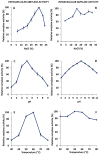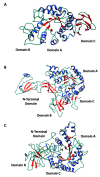Biochemical Characterization of the Amylase Activity from the New Haloarchaeal Strain Haloarcula sp. HS Isolated in the Odiel Marshlands
- PMID: 33923574
- PMCID: PMC8073556
- DOI: 10.3390/biology10040337
Biochemical Characterization of the Amylase Activity from the New Haloarchaeal Strain Haloarcula sp. HS Isolated in the Odiel Marshlands
Abstract
Alpha-amylases are a large family of α,1-4-endo-glycosyl hydrolases distributed in all kingdoms of life. The need for poly-extremotolerant amylases encouraged their search in extreme environments, where archaea become ideal candidates to provide new enzymes that are able to work in the harsh conditions demanded in many industrial applications. In this study, a collection of haloarchaea isolated from Odiel saltern ponds in the southwest of Spain was screened for their amylase activity. The strain that exhibited the highest activity was selected and identified as Haloarcula sp. HS. We demonstrated the existence in both, cellular and extracellular extracts of the new strain, of functional α-amylase activities, which showed to be moderately thermotolerant (optimum around 60 °C), extremely halotolerant (optimum over 25% NaCl), and calcium-dependent. The tryptic digestion followed by HPLC-MS/MS analysis of the partially purified cellular and extracellular extracts allowed to identify the sequence of three alpha-amylases, which despite sharing a low sequence identity, exhibited high three-dimensional structure homology, conserving the typical domains and most of the key consensus residues of α-amylases. Moreover, we proved the potential of the extracellular α-amylase from Haloarcula sp. HS to treat bakery wastes under high salinity conditions.
Keywords: amylase; enzymatic characterization; extremozymes; haloarchaea; proteomics.
Conflict of interest statement
The authors declare no conflict of interest. The funders had no role in the design of the study; in the collection, analyses, or interpretation of data; in the writing of the manuscript, or in the decision to publish the results.
Figures








Similar articles
-
Bioactive molecules from haloarchaea: Scope and prospects for industrial and therapeutic applications.Front Microbiol. 2023 Mar 31;14:1113540. doi: 10.3389/fmicb.2023.1113540. eCollection 2023. Front Microbiol. 2023. PMID: 37065149 Free PMC article. Review.
-
Antioxidant, Antimicrobial, and Bioactive Potential of Two New Haloarchaeal Strains Isolated from Odiel Salterns (Southwest Spain).Biology (Basel). 2020 Sep 18;9(9):298. doi: 10.3390/biology9090298. Biology (Basel). 2020. PMID: 32962162 Free PMC article.
-
Production and Characterization of α-Amylase from an Extremely Halophilic Archaeon, Haloferax sp. HA10.Food Technol Biotechnol. 2015 Mar;53(1):11-17. doi: 10.17113/ftb.53.01.15.3824. Food Technol Biotechnol. 2015. PMID: 27904327 Free PMC article.
-
Biochemical and Taxonomic Characterization of Novel Haloarchaeal Strains and Purification of the Recombinant Halotolerant α-Amylase Discovered in the Isolate.Front Microbiol. 2020 Sep 1;11:2082. doi: 10.3389/fmicb.2020.02082. eCollection 2020. Front Microbiol. 2020. PMID: 32983058 Free PMC article.
-
Characterization of a bacterioruberin-producing Haloarchaea isolated from the marshlands of the Odiel river in the southwest of Spain.Biotechnol Prog. 2016 May;32(3):592-600. doi: 10.1002/btpr.2248. Epub 2016 Feb 26. Biotechnol Prog. 2016. PMID: 26871874
Cited by
-
Bioactive molecules from haloarchaea: Scope and prospects for industrial and therapeutic applications.Front Microbiol. 2023 Mar 31;14:1113540. doi: 10.3389/fmicb.2023.1113540. eCollection 2023. Front Microbiol. 2023. PMID: 37065149 Free PMC article. Review.
-
Recent Advancements for Enhanced Biocatalyst and Biotransformation.Mol Biotechnol. 2025 Apr 9. doi: 10.1007/s12033-025-01422-8. Online ahead of print. Mol Biotechnol. 2025. PMID: 40205287 Review.
-
Latest Advances in Protein-Recovery Technologies from Agricultural Waste.Foods. 2021 Nov 9;10(11):2748. doi: 10.3390/foods10112748. Foods. 2021. PMID: 34829028 Free PMC article. Review.
-
Improving plant salt tolerance through Algoriphagus halophytocola sp. nov., isolated from the halophyte Salicornia europaea.Front Microbiol. 2024 Oct 21;15:1466733. doi: 10.3389/fmicb.2024.1466733. eCollection 2024. Front Microbiol. 2024. PMID: 39498140 Free PMC article.
-
Thalassobacillus, a genus of extreme to moderate environmental halophiles with biotechnological potential.World J Microbiol Biotechnol. 2021 Aug 7;37(9):147. doi: 10.1007/s11274-021-03116-0. World J Microbiol Biotechnol. 2021. PMID: 34363544 Review.
References
-
- Kanekar P.P., Kelkar A.S., Dhakephalkar P.K. Halophiles—Taxonomy, Diversity, Physiology and Applications. In: Metzler J.B., editor. Microorganisms in Environmental Management. Volume 9789400722. Springer; Dordrecht, The Netherlands: 2012. pp. 1–34.
-
- Ventosa A., Márquez M.C., Sánchez-Porro C., De La Haba R.R. Taxonomy of Halophilic Archaea and Bacteria. In: Vreeland R.H., editor. Advances in Understanding the Biology of Halophilic Microorganisms. Springer; Dordrecht, The Netherlands: 2012. pp. 59–80.
Grants and funding
LinkOut - more resources
Full Text Sources
Other Literature Sources

